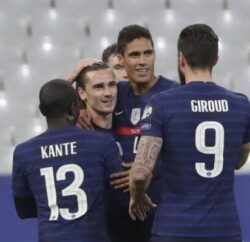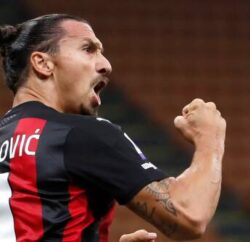You’ll find a different picture if you visit a small town on a sun-kissed Mediterranean island.
“The island is just amazing and I love the sea. I love the calm. Here I can find all these things.”
While other tennis stars such as Novak Djokovic and Victoria Azarenka make their base in the glamorous surrounds of places like Monaco, Nadal escapes the glare of the world media’s attention by returning to his tranquil birthplace.
And now he’s inviting a new generation of players to share that experience, with the launch of his tennis academy in Manacor.
“I don’t know if it’s going to be my last academy, but for me the most important thing is to build the first one here,” Nadal added as he unveiled an accompanying new sports center ahead of Wednesday’s main opening — where his great rival Roger Federer was the star guest.
“It’s where I live, where I’m going to live, and it’s the only chance to really be involved with the project. Having the academy here, I’m here every day so I can see, I can be close to the kids, I can be close to the coaches. I can really enjoy all the process.”
Family ties
The academy will be led by Nadal’s uncle Toni — his longtime coach — and Carlos Costa, a former top-10 tennis pro who has been his agent since 2001.
Family is key to the 30-year-old, whose uncle Miguel Angel was a professional footballer who went to three World Cups with Spain.
Mats Wilander, one of the sports celebrities who helped Nadal launch the sports center, attests to the support he gets.
“I came to watch him practice for three days — it was incredible how one uncle would bring in two freshly-strung rackets, another uncle would come in with lunch, dad was there on and off, back and forth,” the former tennis No. 1 told Open Court.
“They care for each other, and the success of Rafa has to do with the fact that he feels secure in life and he’s just able to go out there and leave it all out there on the court and give absolutely everything, every single point. Not a lot of athletes can do that.”
Indeed, Nadal revealed in his autobiography that the separation of his parents in 2009 caused him such inner turmoil that it manifested itself in severe knee problems.
“My team members were at a loss as to how to react to the gloom that descended on me. They knew I couldn’t keep winning; they knew something had to give. And it did. First it was my knees that went.”
‘Warrior spirit’
Even early in his career, there was a sharp contrast between Nadal the player and Nadal the person, says Carlos Moya — a fellow Mallorcan and one of his early mentors.
“He did not even look at me because he was very shy. He was shaking hands, looking somewhere else,” former world No. 1 Moya recalls of the young teen, who would go from regular practice partner to surpassing him as Spain’s top player.
“But on the court, you could see the look he had and the warrior spirit — you could feel that straight away. I knew that he was a different player.”
Nadal matched Moya’s sole French Open win the first time he played at the clay-court grand slam, aged 19.
He has triumphed on another eight occasions at Roland Garros — a record — but has lost none of his humility despite being one of the most famous sport stars on the planet, says Wilander.
The Swede is now a TV pundit after a career in which he won seven grand slam titles, three of them before the age of 20.
“When you do an interview with Rafa, he comes in and there’s maybe five or six guys in there. So he figures out the makeup girl is sort of the lowest in the ranking. So he goes up, kisses her three times,” Wilander recalls.
“Then he goes up to the presenter, who’s a woman, kisses her three times. Then he starts with the camera assistant man, the camera man and then last me because he kind of thinks I’m the highest ranked in my TV show.
“And he says, ‘Rafa, nice to meet you, Rafa.’ And everybody’s like, ‘Rafa — first of all we know that, second you were here last week man! You don’t have to do that every time.’
“He’s so humble. Every time you see him, it’s just that generosity — he’s unbelievable.”
Nadal is hoping to pass on the qualities that made him such a successful player — instilled by years of intense guidance from his Uncle Toni — to the youngsters who join his academy.
‘Crazy man’
There is some debate as to whether Nadal can regain his past glories.
However, despite the injuries that he seems to suffer each year, he is just three grand slam titles away from matching Roger Federer’s record tally of 17.
“I think Rafa wants to get to 10 French Opens, that’s obvious,” Wilander says. “I think Roger Federer’s 17 majors are still within reach. He’s only 30 years old.
“People are worried about his health. Yes, he’s going to get injured because he’s a crazy man. He takes himself into the ditch. He drives himself into the ground and comes back.
“Realistically he’s going to win at least another grand slam. You cannot think Novak Djokovic is going to dominate completely for the next five years.”
“He’s lost a bit of his aura of invincibility and the other players maybe aren’t as afraid as they used to be, so they hang in there,” McEnroe, also part of Nadal’s sports center launch, told Open Court.
“It’s going to be tough for him. But if he stays healthy for a year or two, I think he’ll win another one.”
‘Fight for important things’
After early exits at two tournaments in China this month, Nadal told reporters he is now focused on getting his game right for 2017 — though he is still in the running to qualify for the season-ending ATP World Tour Finals in London.
Nadal has been sidelined this year with an injury to the left wrist that powers his once formidable forehand, and he told Open Court that a return to full health is key to resurrecting his fortunes on the court.
“The last two months before the injury I had been playing at the highest level, competing against everybody with good chances, and winning events,” he said.
“That’s what I need — be healthy and keep practicing with the same motivation and the rest of the things are going to come back. I believe that I can fight for important things.”
Back at Manacor, there will be a classroom of young kids waiting to see him do just that.










